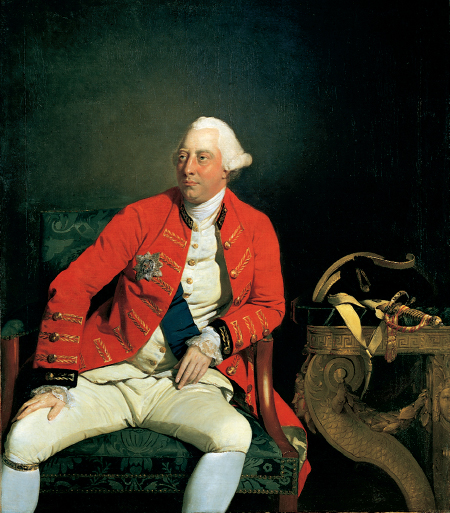America’s History: Printed Page 176
America: A Concise History: Printed Page 156
America’s History: Value Edition: Printed Page 152
The Second Continental Congress Organizes for War
A month later, in May 1775, Patriot leaders gathered in Philadelphia for the Second Continental Congress. As the Congress opened, 3,000 British troops attacked American fortifications on Breed’s Hill and Bunker Hill overlooking Boston. After three assaults and 1,000 casualties, they finally dislodged the Patriot militia. Inspired by his countrymen’s valor, John Adams exhorted the Congress to rise to the “defense of American liberty” by creating a continental army. He nominated George Washington to lead it. After bitter debate, the Congress approved the proposals, but, Adams lamented, only “by bare majorities.”

Congress Versus King George Despite the bloodshed in Massachusetts, a majority in the Congress still hoped for reconciliation. Led by John Dickinson of Pennsylvania, these moderates won approval of a petition expressing loyalty to George III and asking for repeal of oppressive parliamentary legislation. But Samuel Adams, Patrick Henry, and other zealous Patriots drummed up support for a Declaration of the Causes and Necessities of Taking Up Arms. Americans dreaded the “calamities of civil war,” the declaration asserted, but were “resolved to die Freemen rather than to live [as] slaves.” George III failed to exploit the divisions among the Patriots; instead, in August 1775, he issued a Proclamation for Suppressing Rebellion and Sedition.
Before the king’s proclamation reached America, the radicals in the Congress had won support for an invasion of Canada to prevent a British attack from the north. Patriot forces easily defeated the British at Montreal; but in December 1775, they failed to capture Quebec City and withdrew. Meanwhile, American merchants waged the financial warfare promised at the First Continental Congress by cutting off exports to Britain and its West Indian sugar islands. Parliament retaliated with the Prohibitory Act, which outlawed all trade with the rebellious colonies.
Fighting in the South Skirmishes between Patriot and Loyalist forces now broke out in the southern colonies. In Virginia, Patriots ousted Governor Dunmore and forced him to take refuge on a British warship in Chesapeake Bay. Branding the rebels “traitors,” the governor organized two military forces: one white, the Queen’s Own Loyal Virginians; and one black, the Ethiopian Regiment, which enlisted 1,000 slaves who had fled their Patriot owners. In November 1775, Dunmore issued a controversial proclamation promising freedom to black slaves and white indentured servants who joined the Loyalist cause. White planters denounced this “Diabolical scheme,” claiming it “point[ed] a dagger to their Throats.” A new rising of the black and white underclasses, as in Bacon’s Rebellion in the 1670s, seemed a possibility. In Fincastle County in southwestern Virginia, Loyalist planter John Hiell urged workers to support the king, promising “a Servant man” that soon “he and all the negroes would get their freedom.” Frightened by Dunmore’s aggressive tactics, Patriot yeomen and tenants called for a final break with Britain.
In North Carolina, too, military clashes prompted demands for independence. Early in 1776, Josiah Martin, the colony’s royal governor, raised a Loyalist force of 1,500 Scottish Highlanders in the backcountry. In response, Patriots mobilized the lowcountry militia and, in February, defeated Martin’s army at the Battle of Moore’s Creek Bridge, capturing more than 800 Highlanders. Following this victory, radical Patriots in the North Carolina assembly told its representatives to the Continental Congress to join with “other Colonies in declaring Independence, and forming foreign alliances.” In May, the Virginia gentry followed suit: led by James Madison, Edmund Pendleton, and Patrick Henry, the Patriots met in convention and resolved unanimously to support independence.
Occupying Kentucky Beginning in the spring of 1775, in the wake of Dunmore’s War, independent parties of adventurers began to occupy the newly won lands of Kentucky. Daniel Boone led one group to the banks of the Kentucky River, where they established the town of Boonesborough; nearby was Lexington, named in honor of the Massachusetts town that had resisted the redcoats a few months earlier. The Shawnees and other Ohio Indians opposed the settlers, and colonists built their tiny towns in the form of stations to protect themselves — groups of cabins connected by palisades to form small forts.
These western settlers had confused political loyalties. Many had marched under Dunmore and hoped to receive recognition for their claims from the crown. But as the rebellion unfolded, most recognized that the Patriots’ emphasis on liberty and equality squared with their view of the world. They soon petitioned Virginia’s rebel government, asking it to create a new county that would include the Kentucky settlements. They had “Fought and bled” for the land in Dunmore’s War and now wanted to fight against the crown and its Indian allies in the Ohio country. Virginia agreed: in 1776, it organized six new frontier counties and sent arms and ammunition to Kentucky. In July, the Continental Congress followed suit, dispatching troops and arms to the Ohio River as well.
EXPLAIN CONSEQUENCES
Question
How did the violence around Boston in the spring of 1775 affect proceedings in the Second Continental Congress?